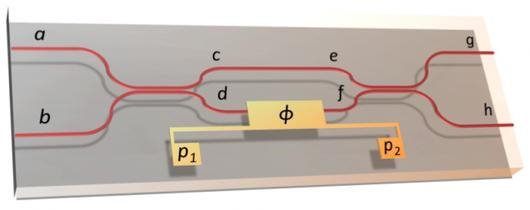Manipulating light on a chip for quantum technologies
 A team of physicists and engineers at Bristol University has demonstrated exquisite control of single photons on a silicon chip to make a major advance towards quantum technologies, including super-powerful quantum computers and ultra-precise measurements. Jeremy O’Brien, Director of the Centre for Quantum Photonics at the Bristol University, who led the research, has demonstrated precise control of four photons using a microscopic metal electrode lithographically patterned onto a silicon chip.
A team of physicists and engineers at Bristol University has demonstrated exquisite control of single photons on a silicon chip to make a major advance towards quantum technologies, including super-powerful quantum computers and ultra-precise measurements. Jeremy O’Brien, Director of the Centre for Quantum Photonics at the Bristol University, who led the research, has demonstrated precise control of four photons using a microscopic metal electrode lithographically patterned onto a silicon chip.
Quantum technologies aim to exploit the unique properties of quantum mechanics, the physics theory that explains how the world works at microscopic scales. For example a quantum computer relies on the fact that quantum particles, such as photons, can exist in a “superposition” of two states at the same time – in stark contrast to the transistors in a PC which can only be in the state “0” or “1”.
Photons are an excellent choice for quantum technologies because they are relatively noise-free; information can be moved around at the speed of light; and manipulating single photons is easy.
Jonathan Matthews and Alberto Politi performed the experiments. The photons propagate in silica waveguides, analogous to optical fibers, patterned on a silicon chip, and are manipulated with the electrode, resulting in a high-performance miniaturized device.
“We have been able to generate and manipulate entangled states of photons on a silicon chip” said Matthews. “These entangled states are responsible for famously ‘weird’ behavior arising in quantum mechanics, but are also at the heart of powerful quantum technologies.”
The team coupled photons into and out of the chip, fabricated at CIP Technologies, using optical fibers. Application of a voltage across the metal electrode changed the temperature of the silica waveguide directly beneath it, thereby changing the path that the photons traveled. By measuring the output of the device they confirmed high-performance manipulation of photons in the chip.
The researchers proved that one of the strangest phenomena of the quantum world, namely “quantum entanglement”, was achieved on-chip with up to four photons. Quantum entanglement of two particles means that the state of either of the particles is not defined, but only their collective state, and results in an instantaneous linking of the particles.
“As well as quantum computing and quantum metrology, on-chip photonic quantum circuits could have important applications in quantum communication, since they can be easily integrated with optical fibers to send photons between remote locations,” said Politi.
“The really exciting thing about this result is that it will enable the development of reconfigurable and adaptive quantum circuits for photons. This opens up all kinds of possibilities,” said O’Brien.










Leave your response!